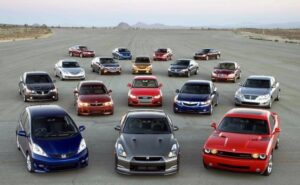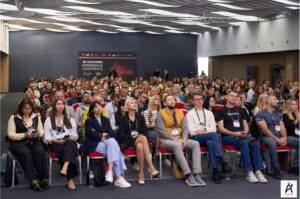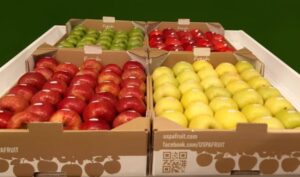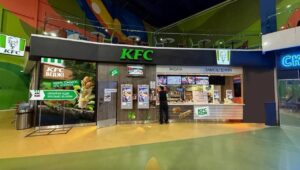
Ukrainians purchased more than 6,800 new passenger cars in September, which is 20% more than in September 2024 and 1% more than in August this year, UkrAvtoprom reported on its Telegram channel.
“For the first time, Chinese BYD took the lead in the market, exceeding its last year’s result by five times,” the message says.
According to the association, BYD’s sales in September amounted to 989 units (5.4 times more than in September last year).
The long-time sales leader, Toyota, took second place in the ranking with sales of 828 cars (-1%); Volkswagen came in third with 733 units (+118%).
Further down the ranking were Renault with 471 units (-13%); Skoda with 467 units (+5%); BMW with 366 units (-16%); Hyundai with 347 units (+47%); Zeekr with 248 units (+103%); Mazda with 244 units (+17%); and Honda with 216 units (+50%).
For the first time, the Volkswagen ID.Unyx electric car became the bestseller of the month.
UkrAvtoprom reports that 52,900 new passenger cars were registered in the country in January-September, which is 0.3% less than last year.
As reported, in 2024, initial registrations of new passenger cars in Ukraine, according to UkrAvtoprom, increased by 14% to 69,600 units.

The build-to-rent segment is gaining momentum in Ukraine, with developer Standard One’s projects maintaining zero vacancy rates and average returns of around 20% per annum in dollars, despite the difficult conditions of the war, the company’s press service reported.
“We are creating a proven financial model that allows our investors to receive stable and predictable income. We build all properties according to the same concept. Investors follow us from project to project because they see real returns,” said Standard One co-owner Alexander Ovcharenko in the podcast “Real Estate Code.”
According to him, thanks to rising real estate prices and rental income, the average return on Standard One projects is currently around 20% per annum in dollars, taking into account capitalization.
He said that before building in Kyiv, the company studied the experience of the US, Austrian, and Polish markets in creating and managing buildings with well-thought-out infrastructure and services.
“When we studied their approach, we set up a mini-laboratory in Kyiv upon our return. It was a kind of ‘test’ apartment in full size. We filled it with furniture and appliances and arranged everything so that future residents would have comfortable housing ready for them. I think we succeeded. Currently, we provide a stable income for investors and offer residents a high level of comfort. The company’s portfolio of properties is growing,” says Ovcharenko.
Standard One’s first build-to-rent project was S1 VDNG, completed in 2019 near the Vystavkovyi Tsentr metro station in Kyiv. All 660 apartments were handed over to investors fully renovated and furnished. The specially created management company S1 Property took over the operational processes: finding tenants, legal support, and 24/7 service for residents. Currently, the occupancy rate in the complex is 99%, and it takes only a few days to find a tenant.
Focusing on residents’ requests, Standard One creates large co-working lobbies, develops service infrastructure near the buildings, and implements innovative engineering solutions in the buildings themselves. For example, one of the company’s new projects will install geothermal heat pumps, which will significantly reduce heating costs and make the building self-sufficient.
According to Ovcharenko, Standard One is reviving the tradition of Kyiv’s apartment buildings, which at the beginning of the 20th century provided the city with quality housing and a stable income for investors. “We combine historical heritage with international practices and modern technologies,” emphasizes Alexander Ovcharenko.
Standard One (S1) is a full-cycle development company that has been developing the build-to-rent real estate segment in Kyiv since 2016. Its portfolio includes the completed S1 VDNG project and the new S1 Obolon, S1 Terminal, and S1 Nyvky buildings.

Ripple’s participation in the pilot projects of national digital currencies (CBDCs) has helped the company to better understand the needs of central banks and the role of commercial players in the future financial system. This was stated by former Ripple CBDC advisor Anthony Welfer.
Since 2021, Ripple has been involved in testing digital currencies with a number of countries. The partners included Palau, Montenegro, Bhutan, Georgia, and the United Kingdom. According to Welfer, these projects not only allowed the technology to be tested in practice but also spurred the development of the XRP Ledger (XRPL).
“CBDC experiments have shown that the main challenge of the future is interoperability. CBDCs, stablecoins, and tokenized deposits should work together to make it easy and convenient for people and businesses to use them,” he emphasized.
Back in 2023, the company introduced an XRPL-based platform for issuing both CBDCs and stablecoins. In August 2025, it launched its own RLUSD token pegged to the US dollar. The coin operates on both the XRPL and Ethereum networks. The capitalization of RLUSD has already approached $790 million, which remains a small share of the global stablecoin market (over $300 billion).
At the same time, Ripple announced a partnership with DBS and Franklin Templeton to launch trading and credit tokenized products based on XRPL and RLUSD.
In this way, the company is trying to integrate into the fast-growing digital asset sector, using the experience gained in pilots with governments.
https://www.fixygen.ua/news/20251001/eks-menedzher-ripple-cbdc-proekti-zminili-rozvitok-xrpl.html

On September 26, Kyiv hosted the 19th CUSTOMER EXPERIENCE CONFERENCE, the only cross-industry event in Ukraine that brought together business leaders and experts in the field of customer experience.
This year’s theme, “A System for Profit,” was a response to a key challenge for companies: how to make customer experience not a one-time initiative, but an operating system that has a consistent impact on profit, reputation, and business development.
The conference was attended offline and online by 500 top managers, team leaders, and experts from various industries who strive to create effective service standards.
In her welcoming speech, KA Group founder Alona Zhupikova emphasized that customer experience always marks the beginning of a new stage of development:
“Customers change, contexts change, technologies change. CX is a living organism, and the task of business is to understand how it works and respond in a timely manner.”
She stressed that it is data research, language analytics, and the implementation of AI solutions that help predict customer needs and create products of the future.
From strategy to measurement
Olena Tsysar, an international expert in strategic development at SK, presented a model of customer experience maturity, which she described as a “mosaic” of three elements: motivation, organization, and culture.
“Our main goal is to bring the customer’s voice back into the business. CX is not just about standards or handling complaints. It’s about humanity and respect for the journey of each customer and employee,“ she emphasized.
Kirill Yezhov, Business Development Director at Kantar Ukraine, continued the theme. He stressed that without clear metrics and accountability, customer experience remains just a good idea:
”82% of CEOs worldwide consider customer experience to be a growth factor. But real results only come when a company can not only listen to the customer, but also act quickly based on data.”
He presented an approach that combines X-Data (customer emotions and experiences) and O-Data (operational metrics), emphasizing the importance of consistency in processes, roles, and culture in creating a CX management system.
Examples of change: from a bank to a super-premium brand
Yulia Moroz, Sales Director at Oschadbank, shared her experience of a large-scale service transformation. Thanks to automation and multi-channel services, more than 70% of customer inquiries are now handled by a voice assistant.
“The customer is the starting point for all changes. Only when CX works as a team system does the customer receive fast and seamless service,” she noted.
Every year, Oschadbank processes 400,000 requests and remains the only bank that has mobile branches even in frontline territories.
Oleksandr Kotolup, founder of Figaro Catering, continued this theme. He focused on the importance of emotions in service: “The WOW effect is an emotion of surprise and joy that brings money, repeat customers, and high loyalty. Emotions work, and they need to be directed in the same way as the fashion industry does.”
Igor Blystiv, Director of Marketing and Innovation at Kormotech, explained how working with three key audiences—veterinarians, breeders, and end consumers—enabled the company to build an entire ecosystem for the Optimeal brand, which strengthened its position in the market.
“Look at the customer on the scale of the entire ecosystem. Create long-term initiatives that become pieces of something bigger,” emphasized Igor Blystiv.
Journey management in action
Oleg Koss, founder of Lanka.CX, focused on dynamic customer journey maps. He explained that journey management should be a living tool integrated into the daily work of teams. According to international research, implementing this approach results in:
+37% increase in customer satisfaction,
+15% additional sales,
+18% improvement in customer retention.
“Complex services need a conductor. Journey management synchronizes teams and helps them focus on a common result,” the expert noted.
Simplicity as a strategy
Mykola Chumak, co-founder and CEO of IDNT, concluded the substantive part of the presentations with the topic of simplicity in services and products.
“Simplicity is not minimalism. It is a strategic cleansing of the superfluous, which allows customers to interact with the company quickly and clearly,” explained Mykola Chumak.
He highlighted five principles of simplicity: empathy, understanding complexity, focus, human language, and attractive design.
Data-driven CX
The panel discussion “Data-driven CX” brought together experts from Minimal, Uklon, Ajax Systems, Colobridge, and the Banda agency.
They talked about how to combine analytics and creativity so that data not only records results but also helps create a better experience for customers.
Volodymyr Brazhnyk, Marketing Director at Minimal: Data is the basis for decision-making.
Maria Tsvid, Product Manager and Analytics Strategist at Colobridge: Analytics points the way and helps create relevant messages.
Mykola Umanets, Head of Customer Experience Development at Uklon: Metrics must be based on real needs, otherwise they will remain numbers without any real impact.
Maria Nevzorova, Director of Technical Support, Service, and Repair at Ajax Systems: She shared her experience of scaling support services without losing a personalized approach to customers.
Customer voice and innovation
The second panel discussion brought together representatives from Dnipro-M, DILA, WOG, NovaIT, and Revisior. They discussed how to integrate customer voice into product strategy and create a culture of rapid feedback.
Vladislav Zhilikhovsky, Dnipro-M, emphasized that speech analytics allows businesses to hear customers in real time and gain insights that change the quality of service and speed of decision-making.
Iryna Dergachova, DILA, added: “Speech analytics minimizes manipulation because it is based on real customer voices, not assumptions.
Another key point was the technological approach presented by Oleg Kushil, WOG, and Dmytro Romaniuk, NovaIT. They explained how modern algorithms help to quickly analyze thousands of customer conversations and identify problems before they become critical.
The experts agreed that companies that quickly test ideas and feedback become more resilient to market changes and are able to launch new services faster than their competitors.
Practice: CX as a winning strategy
To not only hear ideas but also experience their impact, participants took part in a workshop led by Marina Bereziuk, a business psychologist and service expert. The approach is based on understanding service as an interconnected structure where each element influences the other. Working in teams, participants modeled their own customer experience systems, focusing on four key components: people, processes, monitoring, and motivation. This exercise showed how even small changes in one element can transform the entire system.
Participants’ insights
The conclusion of the conference was a kind of summary in the form of joint reflection. Participants shared their own discoveries and key ideas that they will take with them to work.
Roman Orlov, Kron: “Before the conference, I thought that customer experience was just surveys and changes. Now I see that it is a holistic system where all the tools work together.“
Ruslana Kharuk, EverHelp:
”An impressive customer experience is impossible without a quality employee experience. This is the foundation of success.“
Dmytro Pashko, marketing consultant: ”Customer experience is becoming the main currency of business. Marketing departments are transforming into CX marketing, which deeply studies customer behavior and becomes a point of change within the company.”
Partners
General partner: Oschadbank.
Official partners: Kormotech, Colobridge, and Linkos Group. Thanks to the support of the partners, participants were able to exchange experiences and learn about modern solutions in technology, the food industry, and digital services.
Conclusion
CUSTOMER EXPERIENCE CONFERENCE provided new knowledge, partnerships, and insights that will help Ukrainian companies create a systematic, transparent, and profitable business that develops through customers.
KA Group events calendar: https://kagroup.ua/#kalendar
Contacts: info@kagroup.ua
KA Group – kagroup.ua
Interfax-Ukraine – information partner

In the marketing season 2024-2025 Ukraine exported to foreign markets 16.8 thousand tons of apples worth $10.1 million, EastFruit reports. This figure was 64% lower than a year earlier, when export volumes reached 47 thousand tons. At the same time, the average selling price increased and amounted to about $600 per ton.
From July 2024 to June 2025 Ukraine also imported 18.2 thousand tons of apples, which led to a negative balance in the segment of foreign trade. Almost the entire import volume (18 thousand tons) came in the first half of 2025.
The main buyers of Ukrainian apples were:
United Arab Emirates – 2.9 thousand tons,
Saudi Arabia – 2.9 thousand tons,
Uzbekistan – 1.5 thousand tons,
Turkey – 1.4 thousand tons,
Sweden – 0.9 thousand tons.
The entry of Ukrainian producers into new markets is separately noted. In March 2025, after negotiations with Canada, the Canadian Food Inspection Agency (CFIA) approved a program for exporting fresh apples from Ukraine.
Ukraine has traditionally been among the largest apple producers in Eastern Europe, but export volumes remain volatile. According to EastFruit, the current decline is due to the fall in the harvest and the reduced competitiveness of Ukrainian apples in key markets in the Middle East. At the same time, the opening of new destinations may lay the foundation for a recovery of export potential in the coming years.

On Monday, September 29, the KFC restaurant chain opened its first restaurant in Ukraine with a menu based entirely on plant-based alternatives to meat at the Blockbuster Mall in Kyiv.
According to the company’s press service, the dishes offered are based on mycoprotein, an ingredient derived from a natural mushroom that is rich in protein and fiber, contains no cholesterol, and has a significantly lower carbon footprint compared to animal meat. The recipes also use dairy products and eggs, so the line is positioned as vegetarian rather than vegan.
The menu includes veggie strips, veggie burgers, veggie twisters, rice boxes, and salads with veggie strips. Some dishes are served in special “green” packaging.
The new restaurant design features green accents instead of the traditional red ones. The company emphasizes that the availability of the plant-based line across the entire KFC chain will depend on consumer activity at the pilot restaurant. KFC has been operating in Ukraine since 2012, and the Ukrainian KFC chain currently has over 60 restaurants.